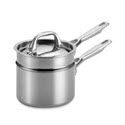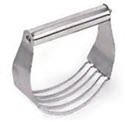Whoever coined the phrase "easy as pie" wasn't talking about lemon meringue pie. There are just so many things that can go wrong with a lemon meringue pie, from flat meringue, to soggy crust, to lumpy lemon filling, that making a perfect lemon meringue pie is anything but easy, and yet still well worth the trouble.
Here are complete, detailed instructions for how to ensure a flawless pie. (But buy pumpkin pie ingredients as a back-up anyway.)
Ingredients
- Filling:
- 2 cup water
- 6 tablespoons butter
- 12 tablespoons lemon Juice (6 or 8 lemons worth)
- 8 egg yolks
- 6 tablespoons cornstarch
- 1/2 teaspoon salt
- 3 cups powdered sugar
- Meringue:
- 8 perfectly pristine egg whites
- 1 cup granulated sugar
- Super Simple Pie Crust
- 1 stick butter
- 2 cup flour
- 1/2 teaspoon salt
Helpful Equipment
Double Boiler—a double boiler is a sauce pan with another pan that fits snugly inside it. You put water in the big pan and put the little pan on top of the water. The idea its that the water keeps the inner pan from getting too hot and over cooking the ingredients. This is important when cooking lemon pie filling because the filling gets gummy if you cook it too hot.

Slotted Spoon—a regular metal spoon with holes in it. This kind of spoon mixes the filling better while you're cooking it and also makes it easier to pick out any bit that get over cooked.

Pastry Cutter—a tool with a sturdy handle with curved blades or rings of wire that you use to mash flour and butter together.

Start by separating your eggs.
This is a recipe where it is absolutely critical that not one tiny bit of yolk get into the white.
Separate your eggs by cracking your whites, one at a time into a separate bowl, put the yoke into a second bowl, then carefully inspect the white part and once you are sure that it is completely clean, put it in a third bowl where you will gather all the whites that have passed inspection. It's OK for the yolks to have egg white with it, but not OK for the white to have yolks. It's nice to pick off the little white cords that hold the yolk to the shell, but they won't hurt the pie. If you have 8 good yolks but you're short one or two eggs worth of white, you need to use more eggs until you have enough for a good amount of meringue. Once you have your 8 pristine egg whites you can put them away in the refrigerator until you're ready to make the meringue.
Make sure the egg whites are safe in the fridge before you start the crust. You don't want any butter from the crust to get in the eggs and contaminate them. Start by chopping the butter into chunks and put it in a mixing bowl with steep sides. Using an electric beater, blend up the butter then add the flour a little bit at a time until it's all well mixed in and the mixture sticks together and you can form the flaky powder into something like a snow ball. At first, as you mix it will seem like too much flour, but at some point it will seem like too little. The more you work it the more creamy and sticky it will become.
When you have added 1 and 1/2 cups flour, mix well one more time and get the mixture to the pasty state, then add the last 1/2 cup of flour and it should get to a state where you can make press it into a ball but it's too dry to hold. When it's like that, move about half of it to a baggie or another bowl, then fluff up what's left and our in 3 table spoons of water. Form it into a ball and knead it a little. Dust it with lots of flour and you can either press it directly into a buttered pie plate, or form it into a ball and flatten it between two sheets of wax paper using a rolling pin. Once it's rolled big and flat enough, take off the top sheet of wax paper and put the buttered pie pan upside down over the rolled crust. Then, put one hand under the bottom sheet of wax paper and flip the whole thing over so that the crust falls into the pie pan. I like to use those new thick plastic cutting boards to roll it onto, because they make it easier to flip the crust into the pie pan. Now press the dough into the pan, pinching the pieces together and forming a nice even edge. For a lemon pie, you want to make high, wide edges to your pie and make them smooth, not flaky, because you need the meringue to stick to the edges.
To make it perfect, put the crust in the freezer after you finish forming it, and take it cold to a hot oven. It really helps crisp it up.
Place the crust in the oven and bake it at about 225 for 10-15 minutes. To avoid problems with air bubbles making it uneven you can cut little slits to let the air out, or place a small oven proof plate on the crust to prevent it puffing up while it cooks.
When it's toasty take it out and let it cool before pouring in the filling. Then cool it again before topping it with meringue.
Lemon Filling
Put two cups of water in the bottom pan of a double boiler and place the inner pan on the water (or just use a regular pan, but keep the burner as low as possible).
Heat two cups of water, not to boiling, about as hot as coffee is good. In a separate two-cup pyrex measuring cup, measure out the cornstarch and use a fork to mix it as you slowly pour in the warm water. Make sure the cornstarch is all nicely dissolved. If it clumps up, dump it and start again.
Pour the corn starch and water into the inner pan of the double boiler.
Add six tablespoons of butter, 12 tablespoons of lemon juice, and three cups of powdered sugar to the cornstarch water. Stir it up, then add the egg yolks and make sure you stir them in well.
Now turn up the heat a little and just stir and stir the mixture with the slotted spoon while you let it slowly boil. It will thicken along the sides of the pan and you will need to scrape it off with the spoon. Keep cooking and mixing and after a while it will get so thick that spoon will leave a imprint when you stir. When you're pretty sure the filling is thick enough, continue cooking and stirring for another 5 minutes to get it really good and thick, then take it off the heat and let it cool some. If it doesn't thicken as it cools, you may want to cook it some more. Taste it. If it's not lemony enough, add a little more lemon juice. Warning: the filling may look like too little to fill the pie, don't worry, it should still add big flavor and the meringue takes up a lot of space.
Meringue
- 8 perfectly pristine egg whites
- 1 cup granulated sugar
Use the egg whites from the first part of the recipe, unless any of them have a tiny spec of yolk, in which case you need to get another egg or make the meringue with only the perfect egg whites you have. Put the whites in a bowl with the 1/2 cup of sugar and beat it mercilessly with an electric beater. The main trick to meringue is to keep everything clean, don't let butter, egg yolk, corn starch, or anything oily get anywhere near the bowl you're working with. The other trick is to use an electric beater and to just keep beating and beating until you've got a really stiff foam.
One more trick is to carefully slide little spoonfuls of meringue on to the filling all around the edge making sure to completely cover the filling, crust to crust. Try to resist the urge to spread the meringue like frosting because that doesn't work. Drop little spoonfuls in concentric circles until the filling is completely covered, and then very gently pile little spoonfuls of meringue as high and spiky as you can, all over the pie. The rough spikes form the prized toasty peaks of the finished pie.
Place the pie in the oven one more time at about 400 degrees for about 10 minutes, just long enough to brown the toasty peaks, then remove it and let it cool a couple of hours.
Over time and especially if you put it in the refrigerator, a lemon pie will develop a little honey "dew", little drops of sweet liquid that develop on the surface. Don't try to wipe them off, they're just part of the recipe.




